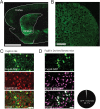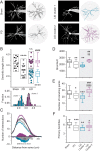Striatonigral neurons divide into two distinct morphological-physiological phenotypes after chronic L-DOPA treatment in parkinsonian rats
- PMID: 29968767
- PMCID: PMC6030109
- DOI: 10.1038/s41598-018-28273-5
Striatonigral neurons divide into two distinct morphological-physiological phenotypes after chronic L-DOPA treatment in parkinsonian rats
Abstract
Dendritic regression of striatal spiny projection neurons (SPNs) is a pathological hallmark of Parkinson's disease (PD). Here we investigate how chronic dopamine denervation and dopamine replacement with L-DOPA affect the morphology and physiology of direct pathway SPNs (dSPNS) in the rat striatum. We used a lentiviral vector optimized for retrograde labeling (FuG-B-GFP) to identify dSPNs in rats with 6-hydroxydopamine (6-OHDA) lesions. Changes in morphology and physiology of dSPNs were assessed through a combination of patch-clamp recordings and two photon microscopy. The 6-OHDA lesion caused a significant reduction in dSPN dendritic complexity. Following chronic L-DOPA treatment, dSPNs segregated into two equal-sized clusters. One group (here called "cluster-1"), showed sustained dendritic atrophy and a partially normalized electrophysiological phenotype. The other one ("cluster-2") exhibited dendritic regrowth and a strong reduction of intrinsic excitability. Interestingly, FosB/∆FosB induction by L-DOPA treatment occurred preferentially in cluster-2 dSPNs. Our study demonstrates the feasibility of retrograde FuG-B-GFP labeling to study dSPNs in the rat and reveals, for the first time, that a subgroup of dSPNs shows dendritic sprouting in response to chronic L-DOPA treatment. Investigating the mechanisms and significance of this response will greatly improve our understanding of the adaptations induced by dopamine replacement therapy in PD.
Conflict of interest statement
The authors declare no competing interests.
Figures





Similar articles
-
Differential Synaptic Remodeling by Dopamine in Direct and Indirect Striatal Projection Neurons in Pitx3-/- Mice, a Genetic Model of Parkinson's Disease.J Neurosci. 2018 Apr 11;38(15):3619-3630. doi: 10.1523/JNEUROSCI.3184-17.2018. Epub 2018 Feb 26. J Neurosci. 2018. PMID: 29483281 Free PMC article.
-
Hyperactive Response of Direct Pathway Striatal Projection Neurons to L-dopa and D1 Agonism in Freely Moving Parkinsonian Mice.Front Neural Circuits. 2018 Jul 30;12:57. doi: 10.3389/fncir.2018.00057. eCollection 2018. Front Neural Circuits. 2018. PMID: 30104963 Free PMC article.
-
L-DOPA Oppositely Regulates Synaptic Strength and Spine Morphology in D1 and D2 Striatal Projection Neurons in Dyskinesia.Cereb Cortex. 2016 Oct 17;26(11):4253-4264. doi: 10.1093/cercor/bhw263. Cereb Cortex. 2016. PMID: 27613437 Free PMC article.
-
Striatal glutamatergic hyperactivity in Parkinson's disease.Neurobiol Dis. 2022 Jun 15;168:105697. doi: 10.1016/j.nbd.2022.105697. Epub 2022 Mar 18. Neurobiol Dis. 2022. PMID: 35314319 Review.
-
Striatal Control of Movement: A Role for New Neuronal (Sub-) Populations?Front Hum Neurosci. 2021 Jul 20;15:697284. doi: 10.3389/fnhum.2021.697284. eCollection 2021. Front Hum Neurosci. 2021. PMID: 34354577 Free PMC article. Review.
Cited by
-
Normalization effect of dopamine replacement therapy on brain functional connectome in Parkinson's disease.Hum Brain Mapp. 2023 Jun 15;44(9):3845-3858. doi: 10.1002/hbm.26316. Epub 2023 May 1. Hum Brain Mapp. 2023. PMID: 37126590 Free PMC article.
-
Alterations in the intrinsic properties of striatal cholinergic interneurons after dopamine lesion and chronic L-DOPA.Elife. 2020 Jul 20;9:e56920. doi: 10.7554/eLife.56920. Elife. 2020. PMID: 32687053 Free PMC article.
-
Differential Activation States of Direct Pathway Striatal Output Neurons during l-DOPA-Induced Dyskinesia Development.J Neurosci. 2024 Jun 26;44(26):e0050242024. doi: 10.1523/JNEUROSCI.0050-24.2024. J Neurosci. 2024. PMID: 38664012 Free PMC article.
-
Striatal synaptic adaptations in Parkinson's disease.Neurobiol Dis. 2022 Jun 1;167:105686. doi: 10.1016/j.nbd.2022.105686. Epub 2022 Mar 8. Neurobiol Dis. 2022. PMID: 35272023 Free PMC article. Review.
-
Dopaminergic modulation of striatal function and Parkinson's disease.J Neural Transm (Vienna). 2019 Apr;126(4):411-422. doi: 10.1007/s00702-019-01997-y. Epub 2019 Apr 1. J Neural Transm (Vienna). 2019. PMID: 30937538 Free PMC article. Review.
References
Publication types
MeSH terms
Substances
LinkOut - more resources
Full Text Sources
Other Literature Sources
Medical
Miscellaneous

